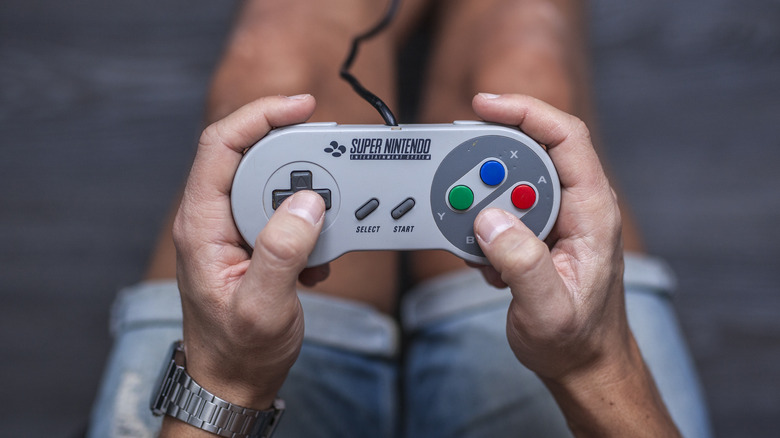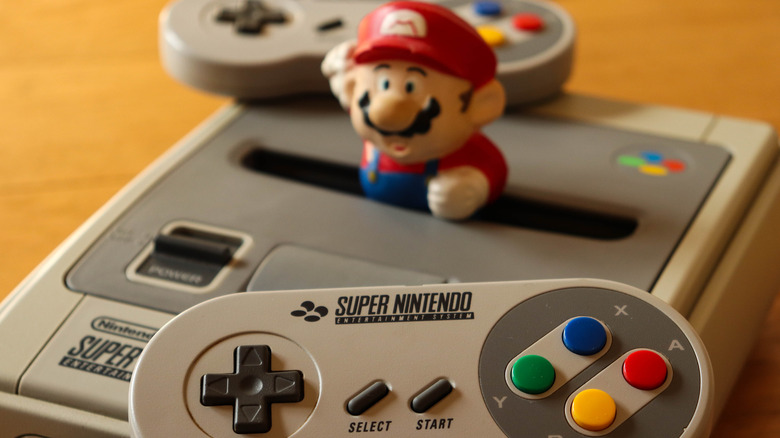

In 1991, after six years of blockbuster success with the Nintendo Entertainment System, Nintendo was looking to make lightning strike twice with a hardware update. Thankfully, with the release of the Super Nintendo Entertainment System, better known as the SNES, the lightning struck again — and then some.
AdvertisementThe SNES was another slam dunk for Nintendo, ruling the 16-bit era with an iron fist and even maintaining a presence into the 32 and 64-bit eras before its discontinuation in 2003. In the 90s, any kid who didn't have a Sega Genesis had a SNES. Its branding is so strong that even its mere image is a selling point, evidenced by the runaway success of Nintendo's SNES Classic compilation console.
With such blinding star power bolstered by the nostalgic memories of those who played SNES games, it's only natural to wonder what a proper SNES console could net you in today's retro gaming market. Here is what you can expect your vintage console to sell for.

Retro hardware shoppers come in two broad flavors — those who intend to actually use the console to play games and those who seek to collect and display it.
The precise value of your SNES depends on how well it's been cared for over the years, as well as whether or not it still has proper packaging. Fun fact, it's actually very easy to discern a Super Nintendo's condition at a glance. Due to a quirk in the plastic that makes it up, the more a SNES has been exposed to the elements over the years, the more its gray body turns a yellowish-brown color. A well-worn SNES can be fun to show to your friends, but it's not much of a selling point.
AdvertisementFor those who just want to play the console, a loose SNES with no packaging will suffice, though the precise price depends on the console's condition. For collectors, the SNES needs to have proper packaging, preferably with minimal wear and tear. If you happen to have a factory-sealed SNES that's never been removed from its box, that's what'll start bringing in the big bucks, to say nothing of a professionally graded SNES.
 Super Nintendo controller" width="780" height="439" />
Super Nintendo controller" width="780" height="439" />
Luza Studios/Getty Images
While it is relatively easy to play the Super Nintendo's software library in one form or another, the simple reputation that comes with being a classic Nintendo console ensures that a SNES in good condition can always fetch a fair price, if not substantially more.
AdvertisementAccording to current sales statistics provided by Price Charting, a loose SNES in good condition with no box can fetch around $90. That's pretty impressive since its original price was only $100 more than that, and it only gets better. If you've got a SNES in a clean box with all of the relevant accessories, the price increases to roughly $260. If you've got a factory-sealed SNES still untouched in its original box, you could potentially sell that thing for around $850.
At peak value is a graded SNES, with its worth determined by a professional appraiser. Graded SNES consoles rarely change hands due to their scarcity, but if you can find the right buyer, you could score as high as $2,600.

Some pictures here/Shutterstock
The Super Nintendo was released at a time before limited-edition console variants were a common practice, so there aren't any super-rare offshoots to keep an eye out for. However, the console did have a couple of variants based on region and price point.
AdvertisementThe PAL version of the SNES was released in Europe and Australia, and while it had a different body and could play region-locked games, it was otherwise functionally identical. Since the Western SNES is the one that most people are nostalgic for, this one isn't worth quite as much. According to Price Charting's current sales statistics, a loose PAL SNES could go for around $50, a complete boxed one for $130, an untouched, factory-sealed one for about $340, and a professionally-graded one for about $380.
There was also the Super Nintendo Jr., also known as the New-Style SNES. This console was released later in the Super Nintendo's lifespan with a lower price point, marketed as a less-intimidating alternative for entry-level gamers. It has a redesigned compact body with a few miscellaneous features trimmed out, though it's overall the same as a regular SNES. According to Price Charting, a loose SNES Jr. could sell for roughly $95, a complete boxed one for an impressive $320, a factory-sealed one for $760, and a graded one for a more modest $850.
Advertisement 
If you're looking to turn a buck on your old Super Nintendo, you've got a few options.
The easiest choice would be to take it to a retail game shop, preferably a locally-owned one. While game shops don't usually like to purchase outdated hardware, nearly all of them will happily make an exception for the Nintendo name. Since they'll need to resell it, though, you won't receive as much money. The same can be said for a reputable pawn shop, which may also present the risk of you getting lowballed.
AdvertisementIf you're looking to make some more cash for your Super Nintendo, your best option would be an eBay listing. This way, you can set your price and communicate directly with potential buyers. It will be a longer process and you may have some misfires, but if you do make a sale, you'll get to pocket 100% of the profits.